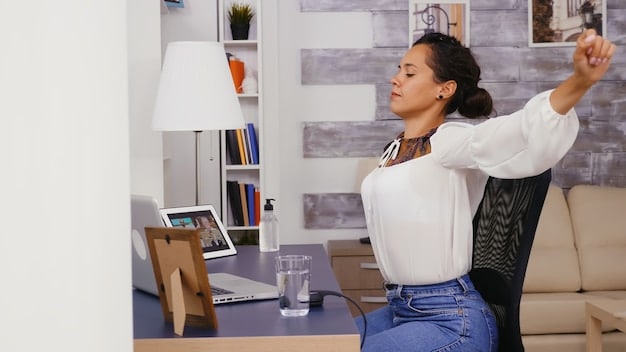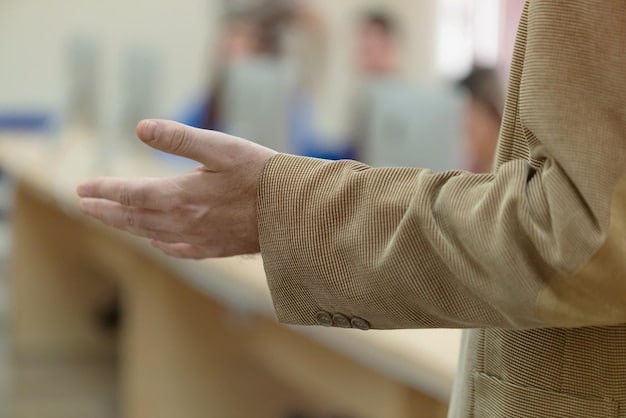Desk Exercises: 5 Simple Ways to Relieve Stress at Work

Relieve stress and tension during your workday with these five simple desk exercises. These practical solutions can be easily incorporated into your routine to promote well-being and improve focus, helping you stay productive and relaxed.
Feeling stressed and tense during your workday? You’re not alone. Many people experience physical and mental discomfort from prolonged sitting and work-related pressures. Discover practical solutions: 5 simple desk exercises to relieve stress and tension during your workday and reclaim your well-being.
Quick Desk Exercises for Stress Relief
Incorporating desk exercises into your daily routine can significantly reduce stress and tension. These exercises require minimal space and time, making them perfect for the workplace. By taking short breaks to stretch and move, you can improve circulation, reduce muscle stiffness, and boost your overall mood.
Neck Rolls for Tension Release
Neck tension is a common issue for desk workers. Simple neck rolls can provide quick relief.
- Gently drop your chin to your chest.
- Slowly roll your right ear towards your right shoulder.
- Pause, then roll your head back to the center.
- Repeat on the left side.

Shoulder Shrugs for Upper Body Relief
Shoulder shrugs are an easy way to release tension in your upper back and shoulders.
- Lift your shoulders towards your ears.
- Hold for a few seconds.
- Release and repeat.
- Do this in a circular motion for best results.
By regularly performing these neck and shoulder exercises, you can alleviate discomfort and improve your posture throughout the day. These simple routines promote better circulation and reduce muscle stiffness, ultimately contributing to a more relaxed and productive work environment.
Seated Chest Stretch
A seated chest stretch can counteract the hunched posture many adopt while working at a desk. This exercise helps open up the chest, improving breathing and reducing upper back pain. This stretch is easily done in your chair and requires no extra equipment.
Begin by sitting upright in your chair with your feet flat on the floor. Clasp your hands behind your back, interlacing your fingers if possible. If you can’t fully interlace your fingers, simply hold your wrists or forearms. Gently and slowly lift your hands away from your body while squeezing your shoulder blades together. You should feel a stretch across your chest and the front of your shoulders.
Hold this position for 15-30 seconds, breathing deeply and evenly. Avoid arching your back excessively; maintain a neutral spine to prevent strain. Release the stretch slowly and repeat 2-3 times. This seated chest stretch can be done several times throughout the day, whenever you feel tension building up in your chest and shoulders. Regular practice helps to improve posture and reduce muscle stiffness.
Variations and Modifications
For a deeper stretch, you can gently tilt your head back while performing the chest stretch, being careful not to strain your neck. To modify the stretch, you can use a resistance band wrapped around your hands to provide added resistance as you pull your hands apart. Regardless of the variation, ensure you are always comfortable and not pushing yourself beyond your limits. Listen to your body and stop if you feel any pain.
Integrating this simple exercise into your daily routine can lead to significant improvements in posture and overall comfort, contributing to a more stress-free and productive workday. Regular practice can help counteract the negative effects of prolonged sitting, making you feel more energized and relaxed.
Effective Hand and Wrist Exercises
Typing all day can cause strain and discomfort in your hands and wrists. Regular exercises can help alleviate these issues. Performing these activities during short breaks can improve flexibility, reduce tension, and prevent conditions like carpal tunnel syndrome. These exercises are easy to incorporate and require no special equipment.
Start with simple wrist rotations. Gently rotate your wrists clockwise for about 15 seconds, then counterclockwise for another 15 seconds. This helps to improve circulation and reduce stiffness. Next, try finger stretches. Extend your arm out in front of you, palm up. Use your other hand to gently pull each finger back towards your body, holding each stretch for a few seconds. Repeat this with your palm facing down. These stretches target the muscles and tendons in your hands and wrists, promoting flexibility and reducing the risk of injury.
Make a fist and then slowly extend your fingers as wide as possible. Repeat this several times to improve the range of motion in your fingers and hands. To further enhance flexibility, try finger flicks. Flick each finger individually as if you are flicking water off your fingertips. This helps to loosen up the small muscles in your hands and wrists.

- Wrist rotations: Rotate your wrists clockwise and counterclockwise.
- Finger stretches: Gently pull each finger back.
- Fist clenches: Make a fist and extend your fingers wide.
- Finger flicks: Flick each finger individually.
Consistent practice of these hand and wrist exercises can help to alleviate discomfort and prevent more serious conditions. Incorporate these simple routines into your daily work schedule and feel the difference in your hands and wrists.
Seated Spinal Twists
Seated spinal twists are a great way to release tension in your back and improve spinal flexibility. These twists stimulate the muscles along your spine, enhancing mobility and reducing stiffness. Performing a seated spinal twist helps to promote better posture and alleviate the discomfort associated with prolonged sitting. The exercise is easily done in your chair and requires no special equipment.
Begin by sitting upright in your chair with your feet flat on the floor. Place your hands behind your head or gently rest them on your shoulders. Rotate your torso to the right, keeping your hips facing forward. Focus on twisting from your upper back, avoiding any strain on your lower back. Hold the twist for 15-30 seconds, breathing deeply and evenly. Gently return to the center and repeat the twist on the left side.
To deepen the stretch, you can use the back of your chair as leverage. Place one hand on the chair’s back and the other on your thigh. Use your hands to gently guide the twist, being careful not to overstretch. Repeat the exercise 2-3 times on each side, focusing on maintaining a straight spine and breathing deeply.
Benefits of Spinal Twists
- Improves spinal flexibility and mobility.
- Releases tension in the back muscles.
- Promotes better posture.
- Stimulates circulation in the spine.
Incorporating seated spinal twists into your daily routine can lead to significant improvements in back comfort and overall flexibility. Regular practice helps to counteract the negative effects of prolonged sitting, making you feel more energized and relaxed throughout the workday.
Deep Breathing for Immediate Stress Relief
Deep breathing exercises are a powerful tool to combat stress and quickly restore a sense of calm. These exercises can be discreetly done at your desk and require no special equipment or preparation. By focusing on your breath, you can reduce anxiety, lower your heart rate, and clear your mind. Start by sitting comfortably in your chair. Close your eyes if you feel comfortable, or simply lower your gaze.
Inhale slowly and deeply through your nose, allowing your abdomen to expand. Feel the air filling your lungs from the bottom up. Hold your breath for a few seconds, then exhale slowly and completely through your mouth. As you exhale, release any tension you may be holding in your body. Repeat this deep breathing cycle for 5-10 minutes, focusing on the sensation of your breath.
You can also try box breathing, a technique used by Navy SEALs to manage stress. Inhale for a count of four, hold for a count of four, exhale for a count of four, and hold again for a count of four. Repeat this cycle several times to center your mind and calm your nerves.
Adding Mindfulness To your Breathing
- Close your eyes or lower your gaze.
- Inhale deeply through your nose, allowing your abdomen to expand.
- Exhale slowly through your mouth, releasing tension.
- Repeat the cycle for 5-10 minutes.
Regular practice of deep breathing exercises can help you develop a greater sense of self-awareness and emotional regulation. Incorporate these techniques into your daily routine to manage stress and improve your overall well-being. Take a few moments each day to focus on your breath and experience the immediate benefits of relaxation and mental clarity.
| Key Point | Brief Description |
|---|---|
| 🧘 Neck Rolls | Release neck tension with slow, controlled rolls. |
| 💪 Shoulder Shrugs | Alleviate upper back stress by shrugging and rotating shoulders. |
| 👐 Hand Exercises | Reduce wrist strain with rotations and finger stretches. |
| дыха Deep Breathing | Quickly calm down with deep, focused breaths and box breathing. |
Frequently Asked Questions
▼
Aim to incorporate these exercises several times a day, especially when you feel tension building up. Even a few minutes every hour can make a significant difference.
▼
While these exercises can help reduce wrist strain and improve flexibility, they may not completely prevent carpal tunnel syndrome. Consult with a healthcare professional for personalized advice.
▼
These exercises are generally safe for most people. However, if you have any pre-existing conditions or experience pain, consult with a healthcare professional before starting.
▼
You can still perform the seated spinal twist by placing your hands on your knees or thighs for leverage, ensuring you’re twisting from your upper back and not straining your lower back.
▼
Many people experience immediate relief from tension and improved focus after performing these exercises. Consistent practice over time will lead to more significant and lasting benefits.
Conclusion
Incorporating these five simple desk exercises into your workday can significantly reduce stress and tension, promoting well-being and productivity. Make these practical solutions a part of your daily routine to enjoy a more relaxed and focused work life.





